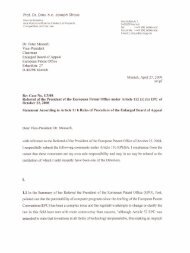Assessing the Obstacles to Industrialisation: The ... - Innovation
Assessing the Obstacles to Industrialisation: The ... - Innovation
Assessing the Obstacles to Industrialisation: The ... - Innovation
You also want an ePaper? Increase the reach of your titles
YUMPU automatically turns print PDFs into web optimized ePapers that Google loves.
16 Stephen H.Habersince <strong>the</strong> data on <strong>the</strong> number of firms includes cigar manufacturers (whichwere not mechanised and <strong>the</strong>refore not subject <strong>to</strong> <strong>the</strong> same kind ofconcentration because of increasing returns <strong>to</strong> scale) as well as cigaretteproducers. Indeed, firm level data from <strong>the</strong> three major cigaretteproducers suggest that <strong>the</strong>y controlled 60 % of <strong>the</strong> market by <strong>the</strong> close of<strong>the</strong> Porfiria<strong>to</strong>.Data on <strong>the</strong> labour force also indicate that <strong>the</strong> big, mechanised firmswere forcing <strong>the</strong> artisanal shops out of business. In 1895 <strong>the</strong>re were 10,397workers employed in cigarette production. By 1910 <strong>the</strong>re were but 6,893,approximately half of whom were employed by <strong>the</strong> nation's three majorfirms.39 If we assume that cigarette output was <strong>the</strong> same in 1895 as it wasin I 898, <strong>the</strong> first year for which output data are available, <strong>the</strong> data indicatethat output per worker increased from 473 kilos in 1895 <strong>to</strong> 1,216 kilos in1910 - an increase in labour productivity of I 17 % over <strong>the</strong> I !-year period- <strong>the</strong> apparent result of <strong>the</strong> substitution of au<strong>to</strong>mated rolling machineryin <strong>the</strong> big firms for thousands of workers rolling cigarettes by hand inhundreds of small shops. <strong>The</strong>se figures, like those on output per fac<strong>to</strong>ry,also tend <strong>to</strong> underestimate <strong>the</strong> degree of change in <strong>the</strong> industry. It isunlikely that output in 1895 was equal <strong>to</strong> <strong>the</strong> level of 1898 - it was almostcertainly significantly lower. Thus, if anything, <strong>the</strong> degree <strong>to</strong> which <strong>the</strong>au<strong>to</strong>mated machinery employed by <strong>the</strong> large firms raised labourproductivity was probably greater than <strong>the</strong> I 5 7 % increase estimatedhere."'Family-owned enterprises remained in Mexico. In some lines ofmanufacturing, like lea<strong>the</strong>r goods, cigars and food processing, small firmscontinued <strong>to</strong> dominate. Even in <strong>the</strong> increasingly concentrated cot<strong>to</strong>n andwool textile industries, small firms that produced for geographicallyisolated areas continued <strong>to</strong> hold out. Wherever <strong>the</strong>re were sizeableeconomies of scale or speed, or where <strong>the</strong> lack of a skilled labour forcecreated incentives <strong>to</strong> mechanise production, however, big firms werepushing <strong>the</strong> small producers out. Because no comprehensive industrialcensus was ever carried out during <strong>the</strong> Porfiria<strong>to</strong>, it is not possible <strong>to</strong>calculate <strong>the</strong> percentage of industrial production attributable <strong>to</strong> large-scalemanufacturing. Data from <strong>the</strong> census of 1929, however, shed some light on<strong>the</strong> subject. As a percentage of <strong>to</strong>tal national production of manufactures,<strong>the</strong> subsec<strong>to</strong>rs that were becoming increasingly concentrated - steel,textiles, cement, beer, dynamite, soap, paper, glass, <strong>to</strong>bacco products -accounted for just over half of all manufactures produced in 1929. I39 Anderson, Oxtcasts in <strong>the</strong>ir Ou~n Land, p. 41.Calculated from Secretaria de Hacienda, Boietin cir estadistica fircaL, 1894 191j (Mexico,L-arious years).





